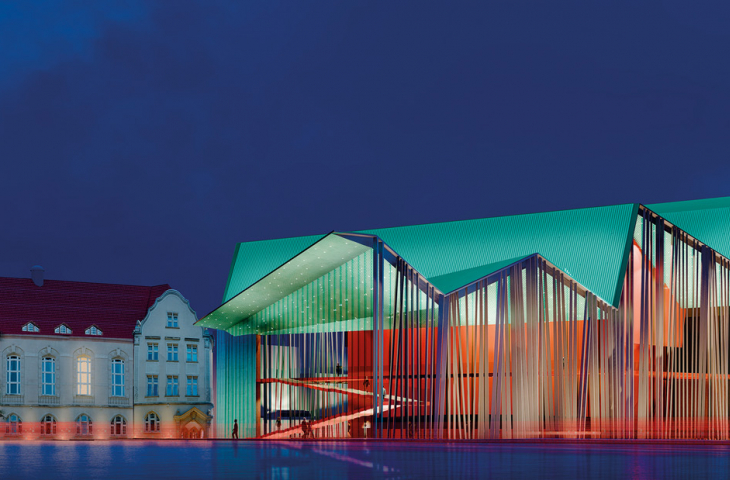AWARDED AND DISTINGUISHED WORKS
First prize - Atelier Loegler Architects
Authors: Romuald Loegler, Sławomir Gębiś, Michał Baniowski
First prize - Atelier Loegler Architects; axonometry
vision: © Atelier Loegler Architekci
AUTHOR'S DESCRIPTION [excerpts].
The intention of the project is not only to give the assigned functions of the theater a precise architectural form. It was also about introducing a new actor into the urban scenery of Św. Marcin Street. The designed Musical Theater building in the urban setting of the street is to provide it with publicity and excellent accessibility for the audience.
The easily recognizable form with its glass facade opens with a sequence of architectural events towards the city, towards the seat of the Music Academy and with the space of the foyer arranged on three levels - towards the audience. The red of the auditorium-viewing room facade gives the foyer space seen from the entrance square the illusion of an atmosphere of luxury.
The geometry of the theater building's mass is key to the organization of the inner space. The spiral of ramps visible in the foreground defines the theater's foyer space, a space "flowing" with a stream of spectators. The image of the theater is the result of a vector of views of the west side of the city dominated by the office building and fairgrounds, an iconic site of Poznan, and the mass of the main building of the Academy of Music.
Located where the city's street grid intersects with the spectacular landscape of railroad tracks, the theater building becomes an object inscribed in the specific context of the place, whose climate is created by the past and the future. They should form a harmonious whole with the surroundings, legitimizing the existing buildings - historical symbols, projecting their past time into the future.
The Musical Theater was set in a geometrically formed plateau - a park of images and sounds of the city - its music. It extends from Św. Marcin Street along the railroad tracks, towards the train station. The park's space is defined by trees, growing out of green circles of lawns - witnesses to the presence of nature contrasted with the architectural landscape of the whole establishment.
The public space created by the park is not just an architectural gesture, it is a well-thought-out arrangement of public space, where light, images and sounds of the city, its sounds create an atmosphere full of surprises and surprises.
The park is a concept of creating a space by simple means, a space that allows passersby not only to experience the city, but also to lie down on the grass, sit down, etc. Standing on the border between the railroad area and the created park space, the existing buildings, witnesses of the history of this part of the city, take on new functions. They are being adapted into "live music" music clubs, gastronomy, theatrical stage art galleries or recording studios! Between the Academy of Music and our Music Theater, in place of the existing parking lot, a new quality is being created, a public space integrating the two facilities dedicated to music. The proposed transformation of this area is intended to reflect the vitality and creativity of the location of the "future" theater, whose "body" with its abstract expression is intended to symbolize the nobility of music, while at the same time announcing in the streetscape the musical events happening there. In other words, it is an enrichment of the context, a chance to create a dialogue between the Music Theater and the Academy of Music.
jury's opinion
The work was given the highest marks for the originality and relevance of the design, especially in the context of the connection with the surroundings and the use of the natural terrain. The court gave the highest marks for the way it relates to the surrounding buildings and the shape of the volume that fits into the panorama of the downtown district. The court noted the openness of the expressive form, the inviting nature of the foyer and the aesthetics of the entrance area.














































































































